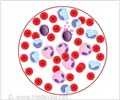Daily doses of a targeted drug called imatinib mesylate along with regular chemotherapy can almost double the survival rate of children with a high risk type of blood cancer called Philadelphia chromosome-positive acute lymphoblastic leukemia (Ph+ ALL), says a new study.
Known commercially as Gleevec, imatinib is a pill that's used to treat some adult leukemias and gastrointestinal cancers.It binds to a specific protein in cancer cells and prevents the cells from proliferating.
"With conventional chemotherapy, the three-year survival rate for children with this high-risk type of leukemia is between 30-35 per cent," said Dr. Kirk Schultz, professor of pediatrics at the University of British Columbia.
"Adding continuous exposure to imatinib for two-and-a-half years made a big difference and increased the survival rates to 87 per cent. The drug was well tolerated and it didn't have any significant side effects," he added.
Since traditional chemotherapy doesn't work well for many children with Ph+ ALL, the standard treatment is blood and marrow transplantation, a life-saving procedure that's associated with a risk of complications.
During the study, researchers recruited 92 children and adolescents between one and 21 years of age with Ph+ ALL and to five different groups that received imatinib for different lengths of time.
Advertisement
Groups that received imatinib for 84 and 126 days showed moderate improvement in survival rates, while groups receiving the drug for 42 and 63 days had the same survival rates as current standard treatments.
Advertisement
"I never expected these results. Although it's very promising, we need to do more follow up to get the five-year survival data and determine the long-term survival.
"We submitted our study for publication earlier instead of waiting because the data was so exciting and this type of leukemia is such high risk," he added.
Source-ANI
RAS







